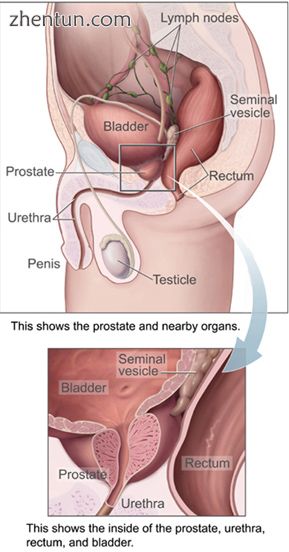
男性解剖学
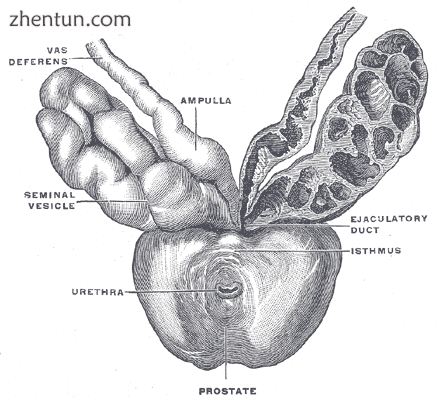
从前面和上面看前列腺囊肿和精囊。
前列腺(来自古希腊语προστάτης,前列腺,字面意思是“站在前面的人”,“保护者”,“监护人”)是大多数哺乳动物中男性生殖系统的复合小管肺泡外分泌腺。它在解剖学,化学和生理学上在物种之间存在很大差异。
前列腺的功能是分泌略微碱性的液体,乳白色或白色,在人类中通常构成精液体积的约30%以及精子和精囊液。精液整体呈碱性,其他贡献腺体的分泌物,至少包括精囊液。精液的碱度有助于中和阴道的酸度,延长精子的寿命。前列腺液与大部分精子一起排出精液的第一部分。与少量与精囊液一起排出的精子相比,前列腺液中的精子具有更好的活力,更长的存活率和更好的遗传物质保护作用。
前列腺还含有一些平滑的肌肉,有助于在射精时驱逐精液。
目录
1 结构
1.1 区
1.2 裂片
1.3 发展
1.4 组织学
2 功能
2.1 男性性反应
2.2 分泌物
2.3 调节
3 基因和蛋白质表达
4 临床意义
4.1 炎症
4.2 良性前列腺增生
4.3 癌症
4.3.1 输精管切除术和前列腺癌的风险
5 在其他哺乳动物中
6 无脊椎动物
7 其他图像
8 参考
结构体
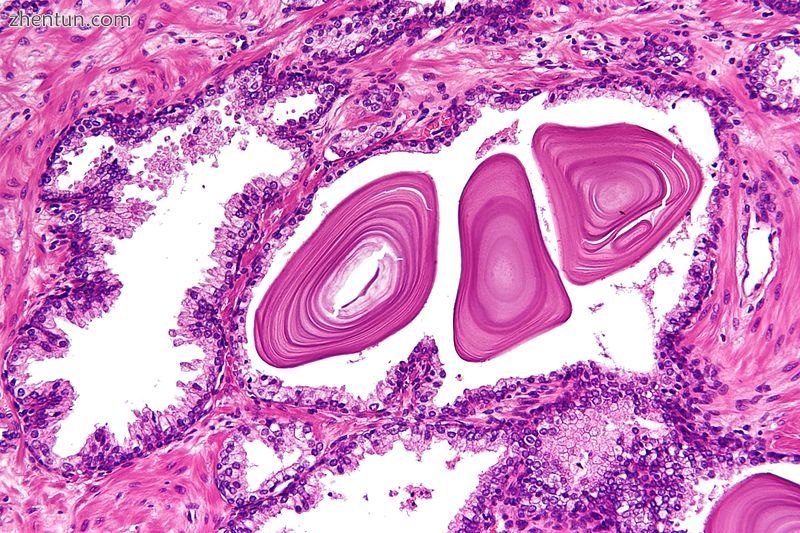
良性前列腺腺体与腺体的显微照片。 H&E染色。
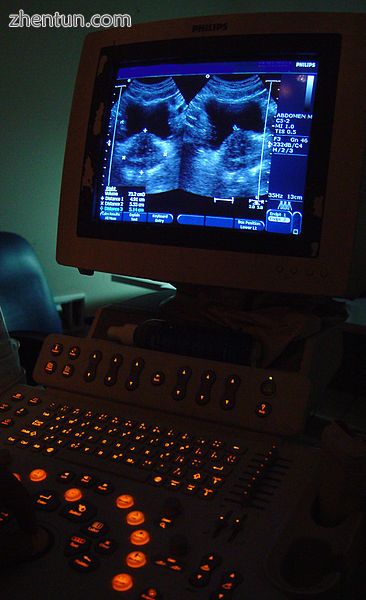
通过医学超声技术可视化膀胱(黑色蝴蝶状)和增生性前列腺(BPH)
健康人类男性前列腺的经典描述将其描绘为略大于核桃。成年男性中正常前列腺的平均重量约为11克,通常在7至16克之间。一项研究表明,活检阴性患者的前列腺体积与体重和身高(体重指数)显着相关,因此有必要控制体重。前列腺围绕膀胱正下方的尿道,在直肠检查期间可以感觉到。
分泌性上皮主要是假复层,包括高柱状细胞和基底细胞,其由纤维弹性基质支持 - 包含随机取向的平滑肌束 - 与膀胱连续。上皮是高度可变的,并且也存在低立方形或鳞状上皮的区域,在较长的管道的远端区域具有过渡上皮。在前列腺内,来自膀胱的尿道称为前列腺尿道,并与两个射精管合并。
人们可以通过两种方式对前列腺进行细分:按区域或按叶。它没有胶囊;而是一个完整的纤维肌肉带环绕它。它被包裹在骨盆底的肌肉中,在射精过程中收缩。
区
“区域”分类更常用于病理学。 1968年John E. McNeal首次提出了“区域”的概念。McNeal发现成人前列腺的相对均匀的切割表面绝不像“裂片”,因此导致了“区域”的描述。
发展
尿道的前列腺部分从泌尿生殖窦的骨盆(中间)部分(内胚层起源)发展而来。内胚层生长来自尿道的前列腺部分并生长到周围的间充质中。前列腺的腺上皮细胞从这些内胚层细胞分化,并且相关的间充质分化成致密的基质和前列腺的平滑肌。前列腺代表男性尿道近端部分的修饰壁,并且在生殖系统发育的第9周胚胎生命中产生。间充质,尿道和沃尔夫管的冷凝产生成人前列腺,这是由几个紧密融合的腺体和非腺体成分组成的复合器官。
组织学
腺细胞
肌上皮细胞
上皮下间质细胞
功能
男性性反应
主要文章:前列腺按摩
在男性精液发射期间,精子通过位于前列腺内的射精管从输精管传递到男性尿道。射精是从尿道排出精液。一些男性可能仅通过刺激前列腺来达到性高潮,例如前列腺按摩或肛交。
分泌物
前列腺分泌物因物种而异。它们通常由单糖组成,通常呈弱碱性。在人前列腺分泌物中,蛋白质含量小于1%并且包括蛋白水解酶,前列腺酸性磷酸酶,β-微蛋白和前列腺特异性抗原。分泌物中还含有浓度为血液浓度500-1,000倍的锌。
调节
为了正常运作,前列腺需要雄性激素(雄激素),这是男性性别特征的原因。主要的雄性激素是睾丸激素,主要由睾丸产生。它是二氢睾酮(DHT),一种睾酮的代谢产物,主要调节前列腺。
基因和蛋白质表达
更多信息:生物信息学§基因和蛋白质表达
大约20,000个蛋白质编码基因在人类细胞中表达,并且这些基因中几乎75%在正常前列腺中表达。这些基因中约有150个在前列腺中更具特异性地表达,其中约20个基因具有高度前列腺特异性。相应的特定蛋白质在前列腺的腺体和分泌细胞中表达,并具有对精液特征重要的功能。一些最前列腺特异性蛋白质的实例是酶,例如前列腺特异性抗原(PSA)和ACPP蛋白质。
临床意义
前列腺的体积可以通过公式0.52×长×宽×高估计。体积超过30 cm3被认为是前列腺肥大(前列腺肥大)。前列腺增生可能是由于以下任何一种情况。
炎症
主要文章:前列腺炎
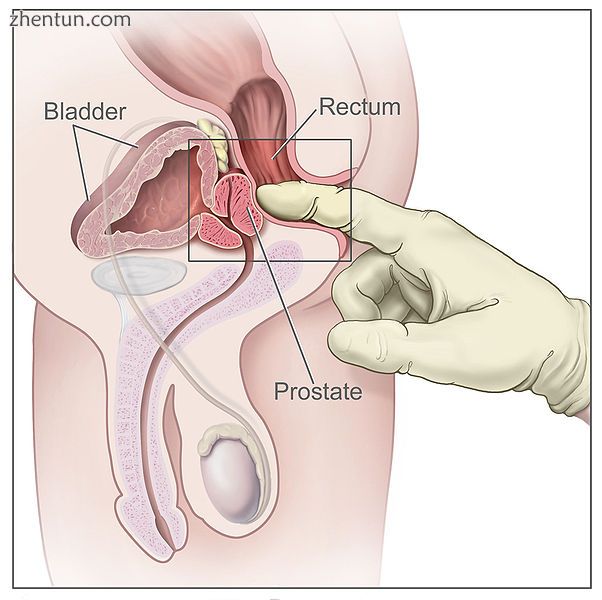
直肠指检可以确定前列腺发炎的方式
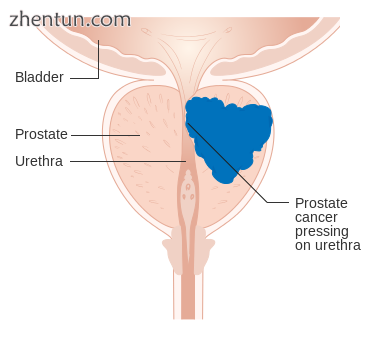
前列腺癌按压尿道的图表,可能导致症状
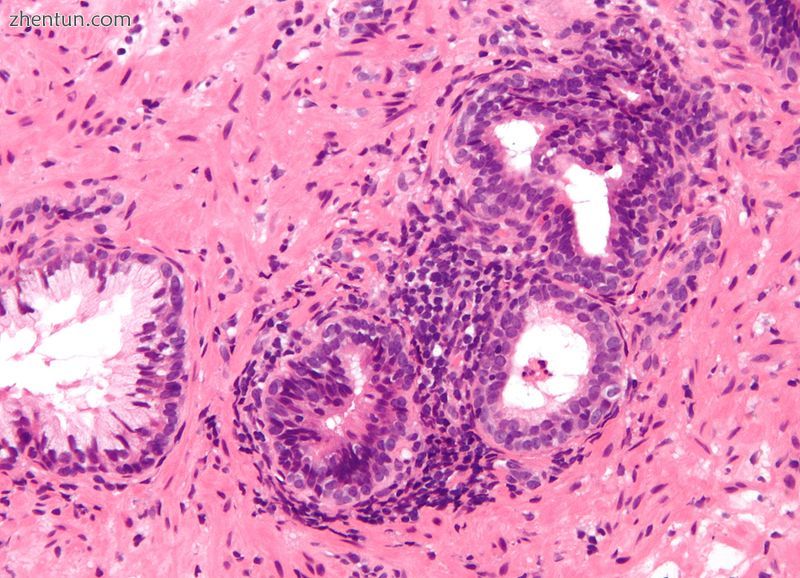
显微照片显示发炎的前列腺,前列腺炎的组织学相关性。 在图像的左侧可以看到正常的非发炎前列腺。 H&E染色。
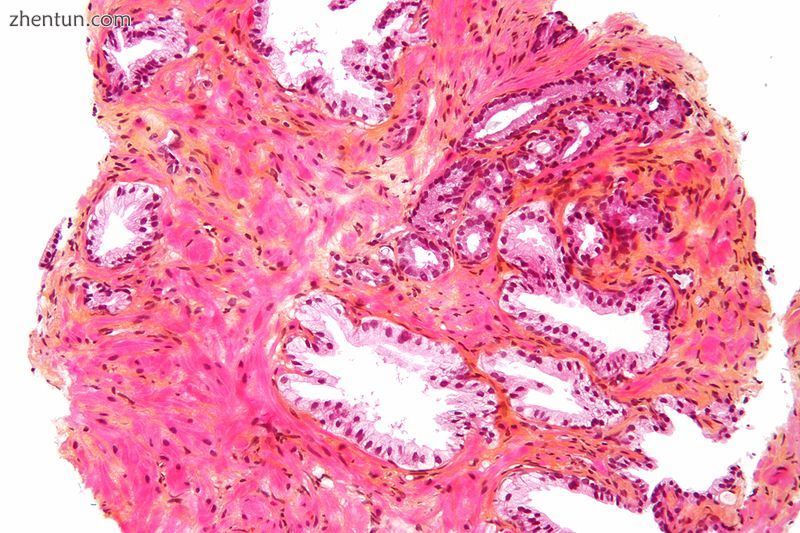
显微照片显示前列腺癌(前列腺腺癌)的正常前列腺和腺体 - 图像的右上方。 HPS染色。前列腺活检。
前列腺炎是前列腺的炎症。主要有四种不同形式的前列腺炎,每种形式都有不同的原因和结果。两种相对不常见的形式,急性前列腺炎和慢性细菌性前列腺炎,用抗生素治疗(分别为I类和II类)。慢性非细菌性前列腺炎或男性慢性盆腔疼痛综合征(III类),包括约95%的前列腺炎诊断,通过多种方式治疗,包括α受体阻滞剂,物理疗法,心理疗法,抗组胺药,抗焦虑药,神经调节剂,植物疗法,手术等等。最近,触发点和心理治疗的组合也被证明对III类前列腺炎有效。 IV类前列腺炎在一般人群中相对罕见,是一种白细胞增多症。
良性前列腺增生症
主要文章:良性前列腺增生
良性前列腺增生(BPH)发生在老年男性身上;前列腺经常扩大到排尿变得困难的程度。症状包括需要经常排尿(频率)或需要一段时间才能开始(犹豫不决)。如果前列腺长得太大,它可能会收缩尿道并阻碍尿液流动,使排尿困难和疼痛,在极端情况下,完全不可能。
BPH可以通过药物治疗,微创手术治疗,或者在极端情况下,可以通过手术切除前列腺。微创手术包括经尿道前列腺电切术(TUNA)和经尿道微波热疗(TUMT)。这些门诊手术之后可以插入临时前列腺支架,以允许正常的自愿排尿,而不会加剧刺激症状。在某些情况下,“肥胖管理可能是减少前列腺体积的有效方法。”
在这种情况下最常使用的手术称为经尿道前列腺切除术(TURP或TUR)。在TURP中,通过尿道插入器械以去除压迫尿道上部并限制尿液流动的前列腺组织。 TURP导致BPH患者的大部分过渡区组织切除。老年男性通常在其前列腺的导管中具有淀粉样蛋白(淀粉样蛋白),钙化蛋白质物质的密集积聚。 amylacea可能会阻塞前列腺管腔,并可能成为某些BPH病例的基础。
由于膀胱痉挛引起的尿频,在老年男性中常见,可能与前列腺增生混淆。统计观察表明,低脂肪和红肉,高蛋白质和蔬菜,以及经常饮酒,可以预防BPH。
改善排尿质量的生活方式改变包括在坐姿排尿。这减少了膀胱中的残余体积,增加了尿流率并减少了排尿时间。
癌症
主要文章:前列腺癌
更多信息:前列腺癌筛查
前列腺癌是发达国家中影响老年男性的最常见癌症之一,也是老年男性死亡的重要原因(一些专家估计为3%)。尽管如此,美国癌症协会关于早期发现的立场是“研究尚未证明测试的潜在好处超过了测试和治疗的危害”。他们认为“如果不了解......测试和治疗的风险和可能的好处,就不应该对男性进行测试”,如果患者是黑人或有父亲或兄弟,应该在50岁或45岁时与医生讨论。在65岁之前获得前列腺癌的人。如果进行检查,可以采用直肠检查的形式,血液中前列腺特异性抗原(PSA)水平的测量,或检查蛋白质Engrailed-2的存在( EN2)在尿液中。
共同研究人员Hardev Pandha和Richard Morgan在2011年3月1日的临床癌症研究期刊上发表了关于检查尿液中EN2的研究结果。目前,实验室测试确定尿液中的EN2,并且设想了类似于家庭妊娠测试条的家庭测试试剂盒。根据摩根的说法,“我们正准备在英国和美国开展几项大型研究,虽然目前还没有EN2测试,但有几家公司表示有兴趣推进这项研究。”
输精管切除术和前列腺癌的风险
1983年,美国医学协会杂志报道了输精管结扎术与前列腺癌风险增加之间的联系。据报道,48,000名和29,000名输精管切除术男性的研究显示,前列腺癌的发病率分别高出66%和56%。风险随着年龄增长和输精管切除术后的年数而增加。
然而,同年3月,国家儿童健康与人类发展研究所召开了由国家癌症研究所和其他机构共同发起的会议,以审查有关前列腺癌和输精管切除术之间关系的现有数据和信息。确定两者之间的关联充其量非常弱,即使进行输精管切除术增加了一个人的风险,风险也相对较小。
1997年,NCI与前列腺癌进展评论小组(科学家,医务人员和其他委员会)举行了会议。他们在1998年发表的最终报告指出,输精管切除术有助于发展前列腺癌的证据充其量是微弱的。
在其他哺乳动物中
除了粪便,貂,獾和水獭外,所有胎盘哺乳动物都发现前列腺是男性附属腺体。雄性有袋动物的前列腺是散布的,并且比胎盘哺乳动物的前列腺大。在一些有袋动物中,前列腺的大小会随季节变化。前列腺的结构各不相同,从小管肺泡(如人类)到分支管状。腺体在狗,狐狸和公猪中特别发达,但在其他哺乳动物中,如公牛,它可能很小而且不显眼。狗可以在一小时内产生与人类一样多的前列腺液。他们排出这种液体和尿液来标记它们的领土。在许多啮齿动物和蝙蝠中,前列腺液含有凝结剂。这在交配期间混合并凝固精液以形成配合的塞子,其暂时防止进一步交配。在鲸类中,前列腺由弥漫性尿道腺组成,并被非常强大的压缩肌包围。
前列腺起源于尿道壁中的组织。 这意味着尿道是一种用于排尿的可压缩管,贯穿前列腺中部。 这导致一些哺乳动物(包括人类雄性)的进化设计缺陷。 前列腺在生命后期易于感染和扩大,使尿道收缩,因此小便变得缓慢和疼痛。
Skene的腺体存在于雌性和啮齿动物中。 从历史上看,它被认为是一个退化器官,但最近发现它产生与男性前列腺相同的蛋白质标记物PSA和PAB。 这意味着Skene的腺体起到女性前列腺的作用,是男性前列腺的组织学同源物。
单孔和有袋动物的痣缺乏前列腺,而是具有更简单的具有其功能的泄殖腔腺体。
在无脊椎动物
前列腺也发生在一些无脊椎动物物种中,例如腹足动物。
其他图片
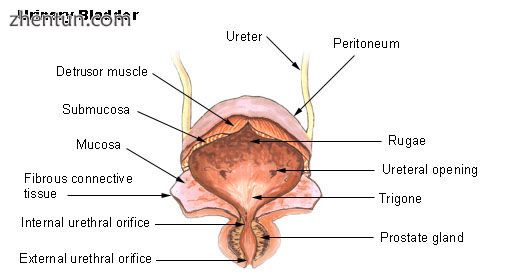
膀胱
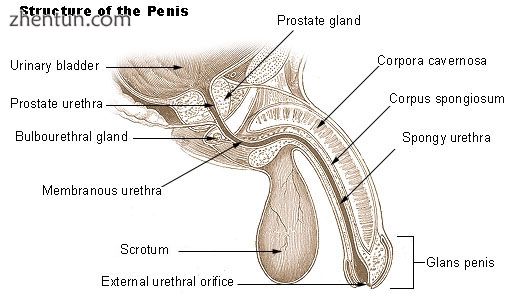
阴茎的结构
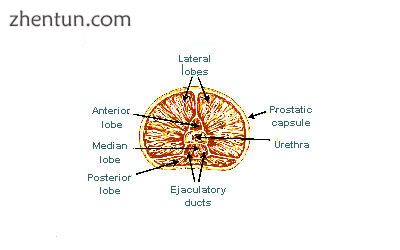
前列腺叶
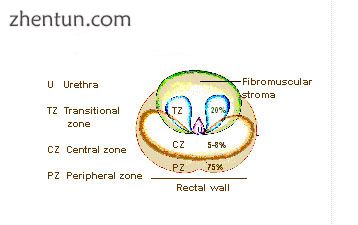
前列腺带
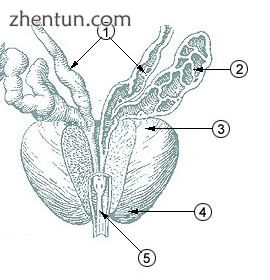
前列腺
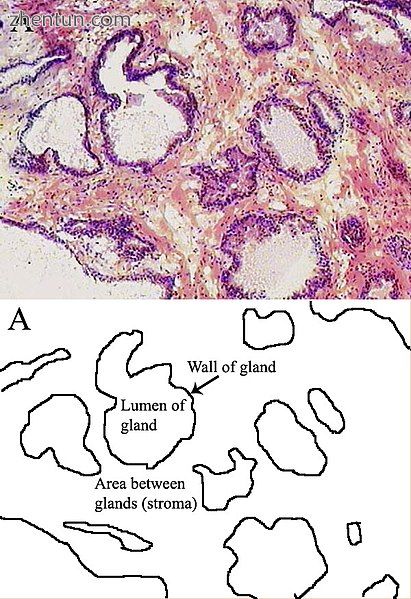
前列腺微小腺体
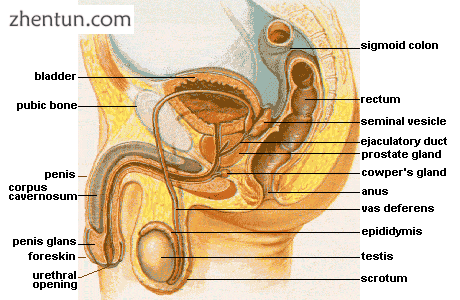
男性解剖学
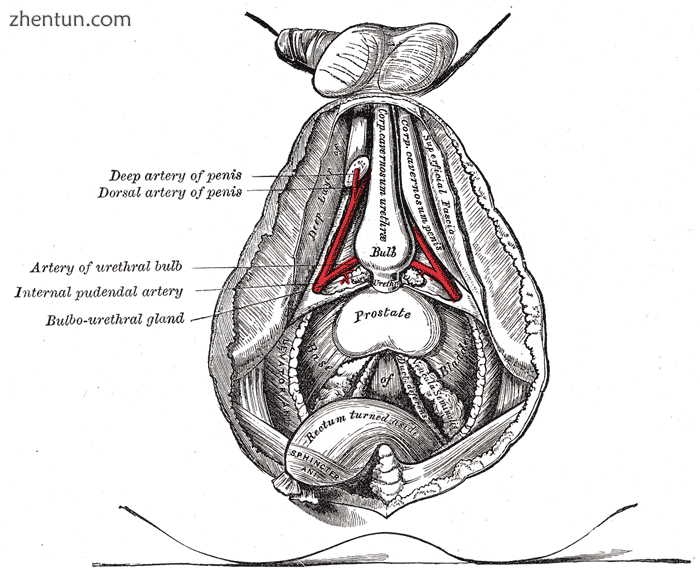
阴部内动脉较深的分支。
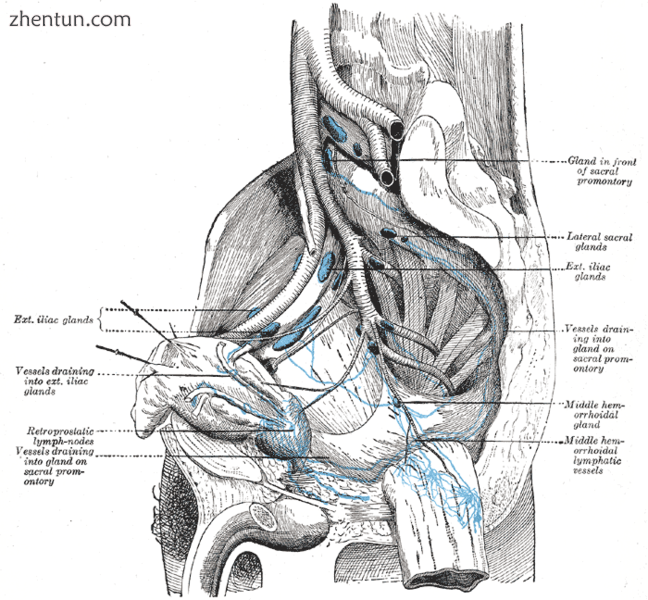
前列腺淋巴管。
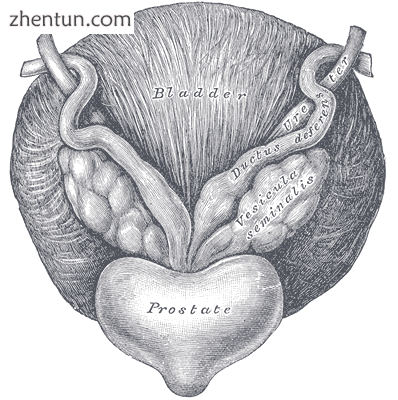
膀胱底,膀胱盏。
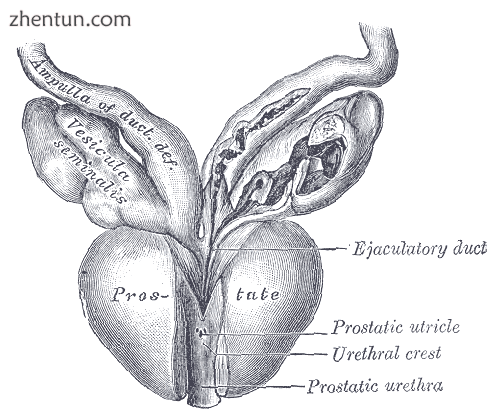
前庭精囊和输精管壶腹。
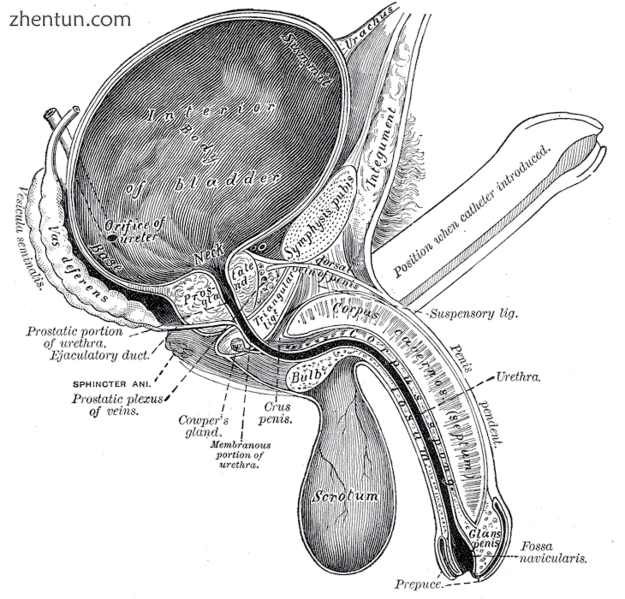
膀胱、阴茎和尿道的垂直切片。
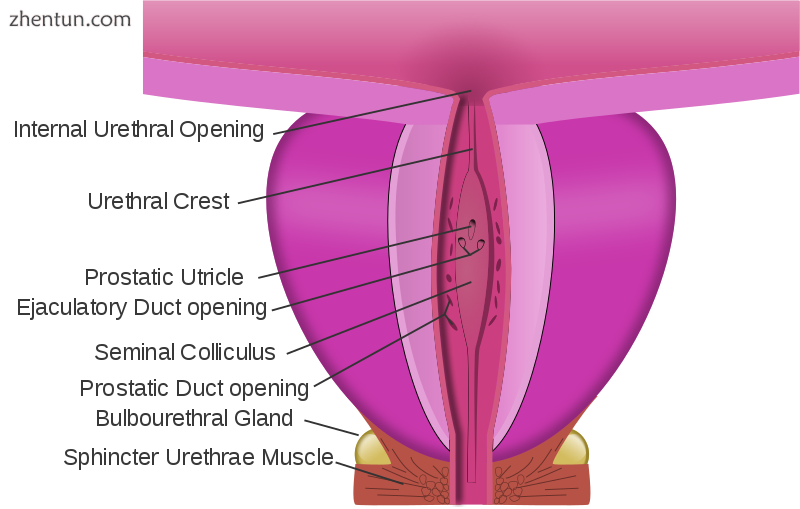
前列腺解剖显示前列腺尿道。
另见
Book: Prostate
Corpora amylacea
Glossary
Further information: Index of oncology articles
参考
Harper, Douglas. "Prostate". Online Etymology Dictionary. Retrieved 2013-11-03.
Romer, Alfred Sherwood; Parsons, Thomas S. (1977). The Vertebrate Body. Philadelphia, PA: Holt-Saunders International. p. 395. ISBN 978-0-03-910284-5.
Tsukise, A.; Yamada, K. (1984). "Complex carbohydrates in the secretory epithelium of the goat prostate". The Histochemical Journal. 16 (3): 311–9. doi:10.1007/BF01003614. PMID 6698810.
"Chemical composition of human semen and of the secretions of the prostate and seminal vehicles". Am J Physiol. 136 (3): 467–473. 1942.
"Semen analysis". www.umc.sunysb.edu. Retrieved 2009-04-28.
Leissner KH, Tisell LE (1979). "The weight of the human prostate". Scand. J. Urol. Nephrol. 13 (2): 137–42. doi:10.3109/00365597909181168. PMID 90380.
Fowke JH, Motley SS, Cookson MS, Concepcion R, Chang SS, Wills ML, Smith-Jr JA (December 19, 2006). "The association between body size, prostate volume and prostate-specific antigen". Prostate Cancer and Prostatic Diseases. 10 (2): 137–142. doi:10.1038/sj.pcan.4500924. PMID 17179979. Retrieved October 5, 2015.
"Prostate Gland Development". ana.ed.ac.uk. Archived from the original on 2003-04-30. Retrieved 2011-08-03.
"The Prostate". Gray's Anatomy. Retrieved 2014-09-12.
"Instant Anatomy – Abdomen – Vessels – Veins – Prostatic plexus". Retrieved 2007-11-23.
Raychaudhuri, B.; Cahill, D. (2008). "Pelvic fasciae in urology". Annals of the Royal College of Surgeons of England. 90 (8): 633–637. doi:10.1308/003588408X321611. PMC 2727803. PMID 18828961.
Myers, Robert P (2000). "Structure of the adult prostate from a clinician's standpoint". Clinical Anatomy. 13 (3): 214–5. doi:10.1002/(SICI)1098-2353(2000)13:3<214::AID-CA10>3.0.CO;2-N. PMID 10797630.
"Basic Principles: Prostate Anatomy". Urology Match. Www.urologymatch.com. Web. 14 June 2010.
"Prostate Cancer Information from the Foundation of the Prostate Gland." Prostate Cancer Treatment Guide. Web. 14 June 2010.
Cohen RJ, Shannon BA, Phillips M, Moorin RE, Wheeler TM, Garrett KL (2008). "Central zone carcinoma of the prostate gland: a distinct tumor type with poor prognostic features". The Journal of Urology. 179 (5): 1762–7, discussion 1767. doi:10.1016/j.juro.2008.01.017. PMID 18343454.
Moore, Keith L.; Persaud, T. V. N.; Torchia, Mark G. (2008). Before We are Born: Essentials of Embryology and Birth Defects (7th ed.). ISBN 978-1-4160-3705-7.
(in English) Gevaert, T; Lerut, E; Joniau, S; Franken, J; Roskams, T; De Ridder, D (2014). "Characterization of subepithelial interstitial cells in normal and pathologic human prostate". Histopathology. 65 (3): 418–28. doi:10.1111/his.12402. PMID 24571575.
"The male hot spot — Massaging the prostate". Go Ask Alice!. 2002-09-27 [Last Updated/Reviewed on 2008-03-28]. Retrieved 2010-04-21.
Rosenthal, Martha (2012). Human Sexuality: From Cells to Society. Cengage Learning. pp. 133–135. ISBN 978-0618755714. Retrieved September 17, 2012.
Komisaruk, Barry R.; Whipple, Beverly; Nasserzadeh, Sara & Beyer-Flores, Carlos (2009). The Orgasm Answer Guide. JHU Press. pp. 108–109. ISBN 978-0-8018-9396-4. Retrieved 6 November 2011.
Alan J., Wein; Louis R., Kavoussi; Alan W., Partin; Craig A., Peters (23 October 2015). Campbell-Walsh Urology (Eleventh ed.). Elsevier Health Sciences. pp. 1005–. ISBN 9780323263740.
"The human proteome in prostate - The Human Protein Atlas". www.proteinatlas.org. Retrieved 2017-09-26.
Uhlén, Mathias; Fagerberg, Linn; Hallström, Björn M.; Lindskog, Cecilia; Oksvold, Per; Mardinoglu, Adil; Sivertsson, Åsa; Kampf, Caroline; Sjöstedt, Evelina (2015-01-23). "Tissue-based map of the human proteome". Science. 347 (6220): 1260419. doi:10.1126/science.1260419. ISSN 0036-8075. PMID 25613900.
O'Hurley, Gillian; Busch, Christer; Fagerberg, Linn; Hallström, Björn M.; Stadler, Charlotte; Tolf, Anna; Lundberg, Emma; Schwenk, Jochen M.; Jirström, Karin (2015-08-03). "Analysis of the Human Prostate-Specific Proteome Defined by Transcriptomics and Antibody-Based Profiling Identifies TMEM79 and ACOXL as Two Putative, Diagnostic Markers in Prostate Cancer". PLOS ONE. 10 (8): e0133449. doi:10.1371/journal.pone.0133449. ISSN 1932-6203. PMC 4523174. PMID 26237329.
"Physical Therapy Treatment for Prostatitis/chronic pelvic pain syndrome". 2014. Retrieved 2014-10-22.
"Quercetin Treatment for Prostatitis/chronic pelvic pain syndrome". 2014. Retrieved 2014-10-22.
Anderson RU, Wise D, Sawyer T, Chan CA (2006). "Sexual dysfunction in men with chronic prostatitis/chronic pelvic pain syndrome: improvement after trigger point release and paradoxical relaxation training". J. Urol. 176 (4 Pt 1): 1534–8, discussion 1538–9. CiteSeerX 10.1.1.383.7495. doi:10.1016/j.juro.2006.06.010. PMID 16952676.
Verhamme KM; Dieleman JP; Bleumink GS; et al. (2002). "Incidence and prevalence of lower urinary tract symptoms suggestive of benign prostatic hyperplasia in primary care—the Triumph project". Eur. Urol. 42 (4): 323–8. doi:10.1016/S0302-2838(02)00354-8. PMID 12361895.
Christensen, TL; Andriole, GL (February 2009). "Benign Prostatic Hyperplasia: Current Treatment Strategies". Consultant. 49 (2).
Dineen MK, Shore ND, Lumerman JH, Saslawsky MJ, Corica AP (2008). "Use of a Temporary Prostatic Stent After Transurethral Microwave Thermotherapy Reduced Voiding Symptoms and Bother Without Exacerbating Irritative Symptoms". J. Urol. 71 (5): 873–877. doi:10.1016/j.urology.2007.12.015. PMID 18374395.
"Slide 33: Prostate, at ouhsc.edu".
Kristal AR; Arnold KB; Schenk JM; et al. (2008). "Dietary patterns, supplement use, and the risk of symptomatic benign prostatic hyperplasia: results from the prostate cancer prevention trial". Am. J. Epidemiol. 167 (8): 925–34. doi:10.1093/aje/kwm389. PMID 18263602.
de Jong, Y; Pinckaers, JH; Ten Brinck, RM; Lycklama à Nijeholt, AA; Dekkers, OM (2014). "Urinating Standing versus Sitting: Position Is of Influence in Men with Prostate Enlargement. A Systematic Review and Meta-Analysis". PLoS ONE. 9 (7): e101320. doi:10.1371/journal.pone.0101320. PMC 4106761. PMID 25051345.
"Watchful Waiting Advised .Some Prostate Patients Benefit". The Daily Courier. Aug 23, 1995. p. 4. Retrieved 10 February 2014.
American Cancer Society American Cancer Society Guidelines for the early detection of cancer Cited: September 2011. Cancer.org. Retrieved on 2013-01-21.
Morgan, R.; Boxall, A.; Bhatt, A.; Bailey, M.; Hindley, R.; Langley, S.; Whitaker, H. C.; Neal, D. E.; Ismail, M. (2011). "Engrailed-2 (EN2): A Tumor Specific Urinary Biomarker for the Early Diagnosis of Prostate Cancer". Clinical Cancer Research. 17 (5): 1090–8. doi:10.1158/1078-0432.CCR-10-2410. PMID 21364037.
New prostate cancer twice as effective as a PSA test could be available by next year. medicinechest.co.uk (2 March 2011)
"Defeating Prostate Cancer: Crucial Directions for Research" (PDF). National Cancer Institute. August 1998. Retrieved 2012-08-19.
Olsen, Bruce D. (2009-05-09). Understanding Human Anatomy Through Evolution (Second ed.). p. 112. ISBN 9780578021645.
Australian Mammal Society (December 1978). Australian Mammal Society. Australian Mammal Society.
Hugh Tyndale-Biscoe; Marilyn Renfree (30 January 1987). Reproductive Physiology of Marsupials. Cambridge University Press. ISBN 978-0-521-33792-2.
C. Hugh Tyndale-Biscoe (2005). Life of Marsupials. Csiro Publishing. ISBN 978-0-643-06257-3.
Sherwood, Lauralee; Klandorf, Hillar; Yancey, Paul (January 2012). Animal Physiology: From Genes to Organisms. p. 779. ISBN 9781133709510.
Nelsen, O. E. (1953) Comparative embryology of the vertebrates Blakiston, page 31.
Glover, Tim (2012-07-12). Mating Males: An Evolutionary Perspective on Mammalian Reproduction. p. 31. ISBN 9781107000018.
Animal reproductive system Encyclopædia Britannica. Retrieved 18 January 2015.
Asdell S A (1965) "Reproduction and Development" In: William Mayer (Ed) Physiological Mammalogy, Volume 2, page 9. Elsevier. ISBN 9780323155250.
William F. Perrin; Bernd Würsig; J.G.M. Thewissen (26 February 2009). Encyclopedia of Marine Mammals. Academic Press. ISBN 978-0-08-091993-5.
Rommel, Sentiel A., D. Ann Pabst, and William A. McLellan. "Functional anatomy of the cetacean reproductive system, with comparisons to the domestic dog." Reproductive Biology and Phylogeny of Cetacea. Science Publishers (2016): 127-145.
Coyne, Jerry A. (2009). Why Evolution is True. p. 90. ISBN 9780199230846.
Zaviačič, Milan (1999). The Human Female Prostate: From Vestigial Skene's Paraurethral Glands and Ducts to Woman's Functional Prostate. ISBN 9788088908500.
Santos, F C A; Taboga, S R (2006). "Female prostate: a review about the biological repercussions of this gland in humans and rodents" (PDF). Animal Reproduction. 3 (1): 3–18.
Knobil and Neill's Physiology of Reproduction. 2005-12-12. p. 1165. ISBN 9780080535272.
Cope, E. D. (1892). "On the Habits and Affinities of the New Australian Mammal, Notoryctes typhlops". The American Naturalist. 26 (302): 121–128. JSTOR 2452234.
Riedelsheimer, B.; Unterberger, Pia; Künzle, H.; Welsch, U. (2007). "Histological study of the cloacal region and associated structures in the hedgehog tenrec Echinops telfairi". Mammalian Biology - Zeitschrift für Säugetierkunde. 72 (6): 330–341. doi:10.1016/j.mambio.2006.10.012.
Barth, Robert; Broshears, Robert (1982). The Mollusks. Philadelphia, PA: Saunders College Publishing. |